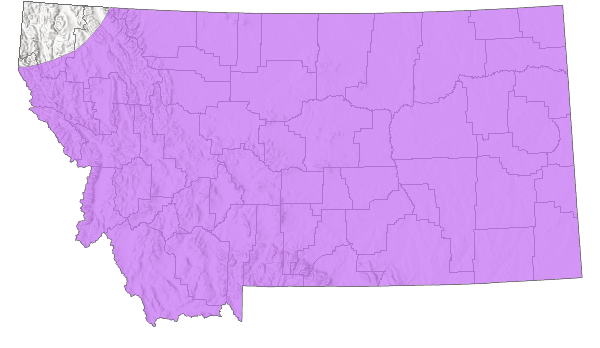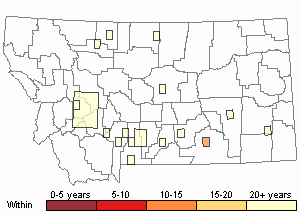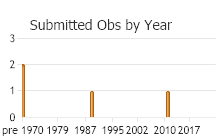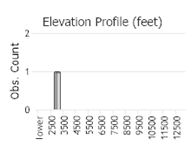View in other NatureServe Network Field Guides
NatureServe
Montana
Utah
Wyoming
Idaho
Wisconsin
British Columbia
South Carolina
Yukon
California
New York
Carlinian Snapper Grasshopper - Circotettix carlinianus
General Description
The following is taken from Brooks (1958), Helfer (1971), Otte (1984), Vickery and Kevan (1985), McDaniel (1987), Capinera et al. (2004), and Scott (2010). All males in the genus Cicotettix are readily recognized in the field by their loud crepitating*, display flights, and hovering in one place high above the ground for several minutes.
The Carlinian Snapper Grasshopper is robust and large. The wings extend beyond the abdominal tip. Its body color is brown with dark speckling and weak transverse bands crossing the forewings and outer face of the hind femur, but can vary to reddish or light gray, which is often influenced by its habitat ground surface color. The hind wings are largely clear, but possess thickened black veins, with smokey-black tinge basally. The inner face of the femur is black with two cream rings and dorsal ridge marking. Most of the early literature, before 1984, places this species in the genus Aerochoreutes.
Communicative behavior/crepitation
Males perform dramatic flight displays by hovering over one spot, loudly crepitating their wings, ascending and descending up-and-down, then dropping to the ground. Observations and analysis of the flights have been reported by Daniel Otte: “Crepitation was produced in bursts of two lengths: long bursts ( 0.75-1.25 seconds); interspersed with one to three very short bursts (about 0.07 seconds). One entire flight consisted of eight long bursts and lasted 15 seconds. The interval between successive long bursts was about 0.25 seconds. During each long burst males ascend, and during silent intervals they descend, thus producing a continuous up-and-down dancing movement. At the end of flight males alighted on the ground within a few feet of their starting points.” They will hover aloft 25 to 50 feet above the ground (Brooks 1958, Otte 1970, 1984, and Vickery and Kevan 1985).
*Crepitation is the sound produced by grasshoppers making a clicking or snapping noise with their wings when in flight, during courtship, territorial encounters or being disturbed.
Phenology
This species overwinters in the egg stage. Adults occur from July to mid-September (Vickery and Kevan 1985, Scott 2010).
Diagnostic Characteristics
The following comes from Brooks (1958), Helfer (1971), Otte (1984), Vickery and Kevan (1985), McDaniel (1987), Capinera et al. (2004), and Scott (2010). The body length of males is 29-40 mm, and for females 33-46 mm.
In Montana, the Carlinian Snapper Grasshopper can visually and by crepitation be confused with any of the other two
Circotettix species, the
Undulant-winged Grasshopper (
Circotettix undulatus) and the
Wrangler Grasshopper (
Circotettix rabula), as well as the
Carolina Grasshopper (
Dissosteira Carolina) and
Crackling Forest Grasshopper (
Trimerotropis verruculata).
Species Range
Montana Range
Range Descriptions

 Native
Native
Range Comments
The Carlinian Snapper Grasshopper occurs from east of the Cascade Range of Washington, Oregon, and eastern California, eastward to the edge of the Dakotas and the western half of Nebraska. From the southeast corner of British Columbia, eastward across the western Canadian Provinces to the southwestern corner of Manitoba, and southward to northern Arizona and New Mexico. In Montana, it has been reported for 26 counties (Otte 1984, Vickery and Kevan 1985, Capinera et al. 2004, and Scott 2010).
Observations in Montana Natural Heritage Program Database
Number of Observations: 20
(Click on the following maps and charts to see full sized version)
Map Help and Descriptions
Relative Density

Recency



 (Observations spanning multiple months or years are excluded from time charts)
(Observations spanning multiple months or years are excluded from time charts)
Habitat
Inhabits open dry prairies and grasslands, along roads, sagebrush steppe, talus slopes, wheat stubble fields and other open areas with a mix of sparse vegetation and bare ground (Otte 1984, Vickery and Kevan 1985, and Capinera et al. 2004).
Food Habits
This species is a mixed grass-feeder, preferring
Western Wheatgrass (
Elymus smithii). It will occasionally consume some forbs (Brooks 1958).
Reproductive Characteristics
No detailed studies have been found in the literature relative to courtship and mating for this species beyond the male flight displays (refer to section on Communicative behavior/crepitation).
Stewardship Responsibility
References
- Literature Cited AboveLegend:
 View Online Publication
View Online Publication Brooks, A.R. 1958. Acridoidea of Southern Alberta, Saskatchewan, and Manitoba (Orthoptera). The Canadian Entomologist (Supplement 9) 90:5-92.
Brooks, A.R. 1958. Acridoidea of Southern Alberta, Saskatchewan, and Manitoba (Orthoptera). The Canadian Entomologist (Supplement 9) 90:5-92. Capinera, J.L., R.D. Scott, and T.J. Walker. 2004. Field Guide to Grasshoppers, Katydids, and Crickets of the United States. Ithaca, NY. Cornell University Press.
Capinera, J.L., R.D. Scott, and T.J. Walker. 2004. Field Guide to Grasshoppers, Katydids, and Crickets of the United States. Ithaca, NY. Cornell University Press. Helfer, J.R. 1971. How to Know the Grasshoppers, Crickets, Cockroaches, and Their Allies. Revised edition (out of print), Mineola, NY: Dover Publications.
Helfer, J.R. 1971. How to Know the Grasshoppers, Crickets, Cockroaches, and Their Allies. Revised edition (out of print), Mineola, NY: Dover Publications. McDaniel, B. 1987. Grasshoppers of South Dakota. Brookings, SD: South Dakota Agricultural Experiment Station, Bulletin TB 89.
McDaniel, B. 1987. Grasshoppers of South Dakota. Brookings, SD: South Dakota Agricultural Experiment Station, Bulletin TB 89. Otte, Daniel. 1970. A comparative study of communicative behavior in grasshoppers. Miscellaneous Publications, Museum of Zoology, No. 141. Ann Arbor, MI: University of Michigan.
Otte, Daniel. 1970. A comparative study of communicative behavior in grasshoppers. Miscellaneous Publications, Museum of Zoology, No. 141. Ann Arbor, MI: University of Michigan. Otte, Daniel. 1984. The North American Grasshoppers Volume II. Acrididae (Oedipodinae). Harvard University Press. 366 pp.
Otte, Daniel. 1984. The North American Grasshoppers Volume II. Acrididae (Oedipodinae). Harvard University Press. 366 pp. Scott, R.D. 2010. Montana Grasshoppers, Katydids, and Crickets A Pictorial Field Guide to the Orthoptera. MagpieMTGraphics, Billings, MT.
Scott, R.D. 2010. Montana Grasshoppers, Katydids, and Crickets A Pictorial Field Guide to the Orthoptera. MagpieMTGraphics, Billings, MT. Vickery, V. R. and D. K. M. Kevan. 1985. The grasshopper, crickets, and related insects of Canada and adjacent regions. Biosystematics Research Institute, Ottawa, Ontario. Publication Number 1777. 918 pp.
Vickery, V. R. and D. K. M. Kevan. 1985. The grasshopper, crickets, and related insects of Canada and adjacent regions. Biosystematics Research Institute, Ottawa, Ontario. Publication Number 1777. 918 pp.
- Additional ReferencesLegend:
 View Online Publication
View Online Publication
Do you know of a citation we're missing? Anderson, N.L. 1962. Grasshopper-vegetation relationships on Montana grasslands. Ph.D Dissertation. Bozeman, Montana: Montana State University. 73 p.
Anderson, N.L. 1962. Grasshopper-vegetation relationships on Montana grasslands. Ph.D Dissertation. Bozeman, Montana: Montana State University. 73 p. Criddle, N. 2019. Studies in the biology of North American Acrididae development and habits. Proceedings of the Entomological Society of Manitoba 75:31-69.
Criddle, N. 2019. Studies in the biology of North American Acrididae development and habits. Proceedings of the Entomological Society of Manitoba 75:31-69. Gillespie, R.L.1992. Dynamics of grasshoppers (Orthoptera: Acrididae) at a rangeland-crop interference. Ph.D. Bozeman, MT: Montana State University. 111 p.
Gillespie, R.L.1992. Dynamics of grasshoppers (Orthoptera: Acrididae) at a rangeland-crop interference. Ph.D. Bozeman, MT: Montana State University. 111 p. Hebard, M. 1928. The Orthoptera of Montana. Proceedings of the Academy of Natural Sciences of Philadelphia, Vol. 80:211-306.
Hebard, M. 1928. The Orthoptera of Montana. Proceedings of the Academy of Natural Sciences of Philadelphia, Vol. 80:211-306. Hebard, M. 1932. Notes on Montana Orthoptera. Proceedings of the Academy of Natural Sciences of Philadelphia. V. 84. pp 251-257.
Hebard, M. 1932. Notes on Montana Orthoptera. Proceedings of the Academy of Natural Sciences of Philadelphia. V. 84. pp 251-257. Skinner, K.F. 1995. Plant and grasshopper community composition: indicators & interactions across three spatial scales. M.Sc. Thesis. Bozeman, MT: Montana State University. 144 p.
Skinner, K.F. 1995. Plant and grasshopper community composition: indicators & interactions across three spatial scales. M.Sc. Thesis. Bozeman, MT: Montana State University. 144 p.
- Web Search Engines for Articles on "Carlinian Snapper Grasshopper"
- Additional Sources of Information Related to "Insects"





